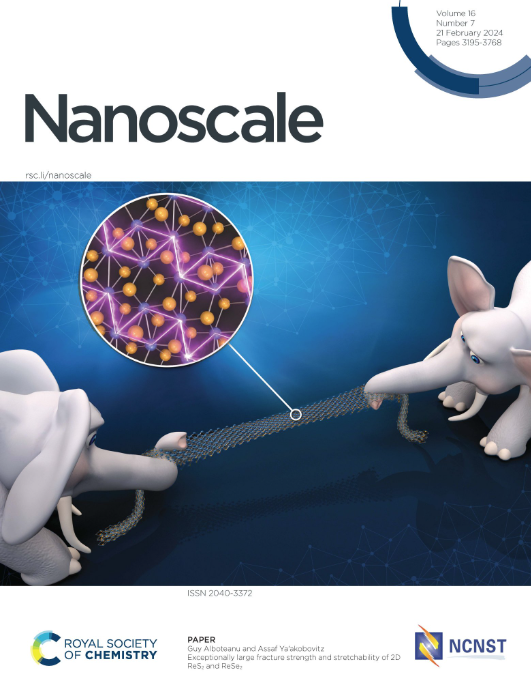Design of “Green” Plasmonic Nanocomposites with Multi-Band Blue Emission for Ultrafast Laser Hyperthermia
IF 5.8
3区 材料科学
Q1 CHEMISTRY, MULTIDISCIPLINARY
引用次数: 0
Abstract
Non-toxic nanoscale materials are widely employed for different healthcare applications but their performance is still considerably limited. In this paper, various approaches of the environment-friendly ultrafast laser processing were employed for remodelling IV group semiconductor nanostructures and synthesizing highly-stable (ξ-potential is up to –47 mV) colloidal solutions of plasmonic (525 nm) nanocomposites with a strong size-dependent chemical content. All nanocomposites exhibited a remarkable lamp-excited multi-band blue emission centred at around 420 nm that is considerably (~10-fold for Au-SiC) stronger for nanocomposites prepared by the laser co-fragmentation technique. The latter formed a larger amount of smaller narrowly-dispersed (~ 4 nm for Au-Si) plasmonic nanostructures as compared to the direct laser ablation. Moreover, it also led to a higher content of semiconductor elements (~1.7-fold for Au-Ge) in nanocomposites correlating with a lower (~ 30 %) electrical conductivity. Aqueous colloidal solutions revealed a higher degree (~ 80 %) of the femtosecond laser-induced heating for all nanocomposites formed by the direct laser ablation. These findings highlight the peculiarities of the used laser processing approaches and considerably facilitate designing of specific multi-modal plasmono-fluorescence (biosensing, bioimaging, hyperthermia) nanocomposites with a required performance significantly enlarging the application area of semiconductor nanostructures.设计用于超快激光热疗的多波段蓝色发射 "绿色 "等离子纳米复合材料
无毒纳米材料被广泛应用于不同的医疗保健领域,但其性能仍受到很大限制。本文采用了多种环境友好型超快激光加工方法来重塑 IV 族半导体纳米结构,并合成了高度稳定(ξ电位高达-47 mV)的等离子体(525 nm)纳米复合材料胶体溶液,其化学成分含量与尺寸密切相关。所有纳米复合材料都显示出以 420 纳米左右为中心的显著灯激发多波段蓝色发射,而采用激光共碎裂技术制备的纳米复合材料的蓝色发射更强(Au-SiC 约为其 10 倍)。与直接激光烧蚀相比,后者形成了更多较小的窄分散(对于 Au-Si,约为 4 纳米)等离子纳米结构。此外,它还使纳米复合材料中的半导体元素含量更高(金-锗为 1.7 倍),导电率更低(约 30%)。胶体水溶液显示,所有通过直接激光烧蚀形成的纳米复合材料的飞秒激光诱导加热程度更高(约为 80%)。这些发现凸显了所使用的激光加工方法的特殊性,并极大地促进了具有所需性能的特定多模式等离子体荧光(生物传感、生物成像、热疗)纳米复合材料的设计,从而显著扩大了半导体纳米结构的应用领域。
本文章由计算机程序翻译,如有差异,请以英文原文为准。
求助全文
约1分钟内获得全文
求助全文
来源期刊

Nanoscale
CHEMISTRY, MULTIDISCIPLINARY-NANOSCIENCE & NANOTECHNOLOGY
CiteScore
12.10
自引率
3.00%
发文量
1628
审稿时长
1.6 months
期刊介绍:
Nanoscale is a high-impact international journal, publishing high-quality research across nanoscience and nanotechnology. Nanoscale publishes a full mix of research articles on experimental and theoretical work, including reviews, communications, and full papers.Highly interdisciplinary, this journal appeals to scientists, researchers and professionals interested in nanoscience and nanotechnology, quantum materials and quantum technology, including the areas of physics, chemistry, biology, medicine, materials, energy/environment, information technology, detection science, healthcare and drug discovery, and electronics.
文献相关原料
| 公司名称 | 产品信息 | 采购帮参考价格 |
|---|
 求助内容:
求助内容: 应助结果提醒方式:
应助结果提醒方式:


